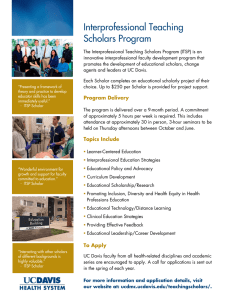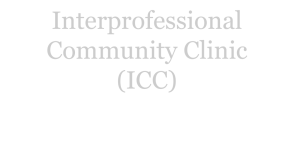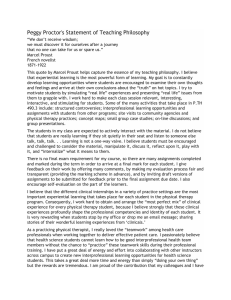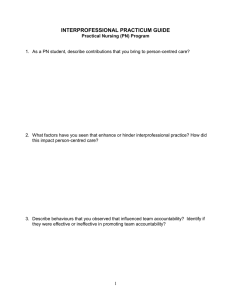“Patient-Centeredness” Module Interprofessional Education Session Jefferson InterProfessional Education Center
advertisement
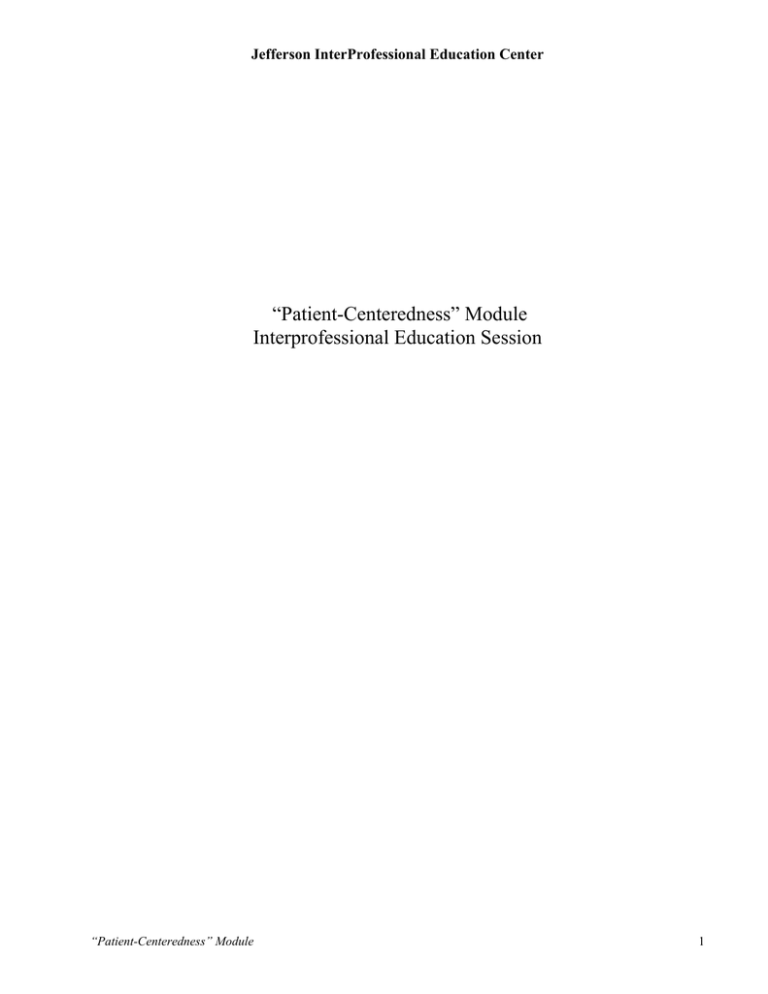
Jefferson InterProfessional Education Center “Patient-Centeredness” Module Interprofessional Education Session “Patient-Centeredness” Module 1 Jefferson InterProfessional Education Center “Patient-Centeredness” Module Interprofessional Education Session Table of Contents Module Overview Teaching Plan Scenarios Evaluation Form “Patient-Centeredness” Module 3 3 7 12 2 Jefferson InterProfessional Education Center “Patient-Centeredness” Module Interprofessional Education Session (2 hours) Module Overview This is a classroom teaching plan/guideline for presentation to learners in any health profession and at any level. Interprofessional education (IPE) is defined as “occurring when two or more professions learn with, from and about each other to improve collaboration and the quality of care”(CAIPE, 2002). This module was developed for a group of over 100 baccalaureate nursing students, 25 radiologic science students, and 25 bioscience laboratory tech students. Faculty members from each of these disciplines (along with medicine) planned the session. The session was cancelled due to a snow storm and will be conducted in the future. The teaching plan can be modified as desired. A powerpoint presentation, Youtube video clip link, and scenarios are provided. The scenarios relate specifically to the learners and should be adapted/developed specifically for the learners involved. Finding health consumer panelists is a challenge. Our panelists were referred from our IPE program, physicians, and faculty members. At least one of our panelists was a “caregiver”/wife. We provided them with the potential questions that they would be asked. Our questions specifically related to the learners/students in the audience. A faculty member moderator planned to guide the panelists as far as time limitations. Teaching plan/guideline Part I (1pm to 1:50pm): 1pm – 1:10pm: Health consumers/patients panel participants Introduction to the class Objectives: At the end of the two-hour session, participants will be able to: 1. appreciate the perspectives of patients/health consumers related to their interactions with the healthcare system including health professionals. 2. apply potential solutions to patient perspectives case scenarios through problem solving and role play. Pre-test to students. Give 3-minute time frame for students to describe their perception of what patient centeredness means and the impact on patient outcomes when patient centeredness is part of their practice. Show first 5 minutes and 48 seconds and end of “you tube” patient centeredness discussion from Canada: http://www.youtube.com/watch?v=h7jHp5ooNec During panel presentation, display on screen the IOM definition of patient centeredness (attached powerpoint). “Patient-Centeredness” Module 3 Jefferson InterProfessional Education Center Institute of Medicine (2001). Crossing the Quality Chasm named “patient-centered” care as one of the 6 fundamental aims of the US healthcare system. IOM defines patient-centered care as: “Healthcare that establishes a partnership among practitioners, patients, and their families (when appropriate) to ensure that decisions respect patients’ wants, needs, and preferences and that patients have the education and support they need to make decisions and participate in their own care” Institute for Family-Centered Care Model (www.familycenteredcare.org) identified core concepts of patient- and family-centered care: Dignity and respect Information sharing Participation in care and decision-making Collaboration with healthcare leaders 1:10pm – 1:40pm: Panel guiding questions (should be adapted for your audience participants): 1. Please tell us in one or two sentences, an overview of your health conditions or for caregivers of the person who you care(d) for (those that you would be willing to share). 2. Would you like to be considered a part of the health care team (involved in decision making about your own health regime)? Why or why not? 3. Would you give an example of when you felt a part of the health care team or when you felt part of the decision making in your own health care? 4. Please give one positive or one negative interaction you have had with one or more of the following professions of the health care team: nurse, radiological technologist, lab technologist (incident related to obtaining lab results). 5. For any negative reaction mentioned, how would you have liked to have the healthcare team member handle the situation differently? 6. Were there any experiences with having or getting the results from specific diagnostic tests (blood work, x-rays, etc) that impacted you in some way? 7. In your experiences with nurses, radiological technologists, and lab technologists (because students from these disciplines are in the audience), do you have any specific advice for students that they should do to make people/patients have a better experience in the healthcare system. You probably have had more interactions with nurses and radiological technologists. The lab technology students “Patient-Centeredness” Module 4 Jefferson InterProfessional Education Center are preparing to be those who will not usually take your blood but will be in the labs conducting the tests and preparing the results for the hospital and health care providers. Any specific advice you could give for each of the professions would be very helpful for our students. 1:40pm – 1:50pm: Q and A from students. We will encourage student questions from the audience. Faculty will ask questions of panelists if needed. Immediately after Q and A: Have students count off to ensure that there are diverse disciplines in each small group. Part II (2pm – 3pm): Small group exercises. Case scenarios/role playing. 2pm – 2:40pm: Provide case scenarios and instructions on how to role- play and discussion questions for each scenario. ADAPT OR DEVELOP NEW SCENARIOS BASED ON YOUR TARGET AUDIENCE. OUR SCENARIOS WERE DEVELOPED BY THE NURSING, RADIOLOGICAL SCIENCE, MEDICINE, AND BIOSCIENCE LAB TECH FACULTY MEMBERS. Encourage students to experience both the health professional and patient role during the role-play scenarios. Prior to the small group exercises, students should introduce themselves and 1) share their program educational curriculum, coursework and clinical experiences and 2) brainstorm ways to promote patient-centered care within their specific practices. 2:40pm – 3pm: Wrap-up session Discussion Questions (will occur simultaneously in each room) 1. During the role-play experiences: a. How did it feel being the patient in the scenario? b. When you role-played the health professionals, what were some ways that your group demonstrated patient-centered interactions? 2. What take away messages did you get from today’s panel and the role-play exercises? 3. Advise students to complete evaluation and the same pre-test question given earlier. Give 3-5 minutes. Be sure to tell students “Patient-Centeredness” Module 5 Jefferson InterProfessional Education Center that the final section of the class will continue after the evaluations completed. 4. Ask students to list what they learned about other professions today? 5. Thank all students for participating in this interprofessional education experience. “Patient-Centeredness” Module 6 Jefferson InterProfessional Education Center Scenarios 1. Jim Jones is a 24-year-old male who saw his family physician complaining of hoarseness and some difficulty swallowing for the past month or so. Family medical history included a history of heart disease on both mother and father’s side of family and thyroid cancer on mother’s side of family. Physical exam noted a single, hard, fixed nodule on thyroid gland with two small surrounding lymph nodes. No other abnormal findings noted. Diagnostic studies ordered were: thyroid blood studies (normal), nuclear thyroid imaging scan (nodule found to not be producing thyroid hormone) and fine needle aspiration biopsy. Background information: During fine needle aspiration (FNA) procedure there is a coordinated effort of a group of medical professionals, which includes: i. Nurse, who fills out the requisition form with all relevant patient information including medical history ii. Pathologist, surgeon, or medical resident, who actually perform the aspiration procedure iii. Anesthesiologist, who provide general anesthesia in certain cases iv. Ultrasound technician, who helps in guiding the needle to the object of the FNA biopsy v. Cytotechnologist, who perform ‘on spot’ express type of cellular specimen’s staining (while patient is still under anesthesia) and screening in order to find out whether sufficient amount of tissue was harvested to make a diagnosis Fine coordination of all medical personnel involved is absolutely crucial for the successful diagnosis. Mr. Jones is in the procedure room and is extremely anxious, visibly shaking, and diaphoretic. The cytotechnologist and ultrasound technologist arrive prior to the physician who will be doing the procedure. Role play instructions: A. A nursing student will play the role of Mr. Jones. You are anxious and your hands are shaking. You ask a number of questions of the cytotechnologist and the ultrasound technologist such as: a. How long will this take? Is it going to hurt? b. To the cytotech: Are you the doctor? What will you be doing during the procedure? c. To the ultrasound tech: What will you be doing? d. When will I know the results? e. What if it shows that I have thyroid cancer, what happens next? B. A radiological science student will play the role of the ultrasound tech. “Patient-Centeredness” Module 7 Jefferson InterProfessional Education Center C. A bioscience student will play the role of the cytotechnologist. After the role-play session is finished, all members of your small group should discuss the following and record your answers: A. Identify interactions that you feel were patient-centered. B. What other patient-centered interactions could have been used? C. For the person who played the role of the patient, what specific actions made you feel that you were treated with respect and as a participant in this healthcare experience? 2. Bill Smith is a 69 year old male who was seen by his healthcare provider for right upper abdominal pain for the past 3 weeks. He has type 2 Diabetes Mellitus and had a stroke two years ago; no history of alcohol abuse, cirrhosis, or hepatitis. There is no family history of cancer. The physical exam was normal, the blood panels were all normal (including a normal AFP – alpha feto-protein level), a CT scan demonstrated a 3 mm mass in the liver. A CTguided liver biopsy to rule out cancer is scheduled for Mr. Smith. Background information: The patient instructions for this procedure are: NPO (because of the use of sedation), no oral sedation (some patients take Valium at home and then are dismayed to find out they cannot receive IV sedation), and cessation of any blood thinning drugs (aspirin, Coumadin, Heparin, herbal medicines etc.). Mr. Smith arrives in the department for the liver biopsy. The CT tech began to tell Mr. Smith the steps of the procedure. Mr. Smith became upset and nervous since he thought he was coming for a scan only and now is told that he was having an eight-inch needle inserted into his liver. In addition, the CT tech notes that there is no blood work on the chart. A PT/PTT must be drawn in order to ensure the patient’s clotting function is adequate. A call is placed to see if the blood work was drawn. It was not. Now the test is delayed further until the lab technician arrives to draw the blood, followed by the wait for the results. In the meanwhile, the anxious patient waits and the procedure is delayed. Role play instructions: A. One student will play the role of the CT tech and tells Mr. Smith the information above (that the procedure is a scan along with a biopsy and the news about having to wait for blood to be drawn). B. One student will play the role of the patient. You will react with nervousness and frustration about what you are told. Some questions that you might ask are: Why do I have to have a needle, I thought it was just another scan? What is wrong with this hospital that I have to wait for the blood work? When do you think I will be able to have the test? Why “Patient-Centeredness” Module 8 Jefferson InterProfessional Education Center do I have to have the blood test anyway? I already had lots of blood tests done at the doctor’s office. What is this test for and when will I have the results? After the role-play session is finished, all members of your small group should discuss the following and record your answers: A. The lab technologist, who is behind the scenes, had an impact on this patient’s experience. How can the actions of the lab tech impact on patient satisfaction? B. Identify interactions of the CT tech that helped Mr. Smith feel more involved and less out of control. C. What other patient-centered interactions could have been used? D. For the person who played the role of the patient, what specific actions made you feel that you were treated with respect and as a participant in this health care experience? 3. Janie Phelps is a 56 year old female who is in the hospital with unexplained weight loss, anorexia, weakness, and fatigue. She has a history of breast cancer. The hospitalist orders a CT simulation of the left lung. The nurse assigned to Ms. Phelps today cared for her the previous 2 days. The therapist calls the floor and speaks to the nurse in order to schedule a time for transport. Upon arrival the therapist realizes that the patient has an implanted pacemaker that could quite possibly lie in the treatment field. Background information: Since the Radiology Oncology department were not aware that Ms. Phelps had an implanted pacemaker, the dosimetrist (specialist in knowledge of the overall characteristics and clinical relevance of radiation oncology treatment machines and equipment) had to be notified in order to 1) make a copy of the pacemaker card (hopefully it’s in the chart) 2) contact the pacemaker company for radiation exposure restrictions and 3) perform specific measurements (adding to wait time for the patient). If the pacemaker had not been identified by the Radiation Oncology Staff, this patient would be in danger of going into atrial fibrillation had the pacemaker been overexposed to ionizing radiation. Role play instructions: A. One student will play the role of the nurse who has been caring for Ms. Phelps the past 3 days. You and the rad tech are in the room with Ms. Phelps and together must explain why the CT simulation is being delayed. B. One student will play the role of the rad tech who discovered the fact that Ms. Phelps has a pacemaker. You and the nurse are in the room with Ms. Phelps and together must explain why the CT simulation is being delayed. C. One student will play the role of Ms. Phelps. You are weak and were feeling so relieved that the CT was going to be done and soon you would have some information about your condition. You repeatedly ask both your nurse and the rad tech why this information wasn’t known prior to the scheduled CT and why you have to wait. Whatever explanations provided to you, ask each one separately to explain it again and again to you. “Patient-Centeredness” Module 9 Jefferson InterProfessional Education Center After the role-play session is finished, all members of your small group should discuss the following and record your answers: A. How did the nurse and rad tech deal with the repeated questions of Ms. Phelps in such a way that she felt respected and part of the healthcare team? B. What other patient-centered interactions could have been used? C. For the person who played the role of Ms. Phelps, what specific actions made you feel that you were treated with respect and as a participant in this healthcare experience? D. What could have been done to prevent this situation from occurring at all? 4. Ms. Kim is a 42-year-old who recently moved to Philadelphia from Korea. Her primary language is Korean and speaks little English. She arrives to the emergency department with reports of “coughing up blood” (hemoptysis). There is a 20-year-old nephew with Ms. Kim who interprets for her. She is escorted to room 5 for evaluation by the healthcare team. Initial orders include: Intravenous infusion of .9 saline at 80ml/hour, Portable CXR, Blood work – BMP, CBC, PT/PTT, sputum specimen. Background Information: Since the patient speaks Korean, the interpreter has left her and the staff must convey to Ms. Kim the procedures that were ordered. The nurse must start the intravenous; the radiology technician will do the portable CXR, the phlebotomist will draw her blood and the lab technician will analyze the blood studies. Ms. Kim appears anxious and starts to cough. Role play instructions: A. One student will play Ms. Kim, who appears anxious and starts to cough. B. One student will play the role of the nurse, who will explain the intravenous rationale and procedure and provides the patient with a specimen container for the sputum sample. C. One student will play the role of the radiology technician who will explain to Ms. Kim the portable CXR rationale and procedure. D. One student will play the role of the phlebotomist who will explain to Ms. Kim the rationale for the blood work and procedure. After the role-play session is finished, all members of your small group should discuss the following and record your answers: A. How did the various disciplines handle explaining to the patient rationales and procedures? B. How did the student who played Ms. Kim feel about not being understood or not understanding what was said to her? C. What other patient-centered interactions could have been used? “Patient-Centeredness” Module 10 Jefferson InterProfessional Education Center D. What steps could be taken to ensure accurate interpretation to patients who do not speak English? “Patient-Centeredness” Module 11 Jefferson InterProfessional Education Center Evaluation Form Please complete and hand in prior to the class session and panel presentation. _______ Nursing _______ Radiological Science _______ Bioscience Technologies ADAPT FOR YOUR AUDIENCE The topic of today’s interprofessional education seminar is “patient centeredness and the health care team”. Please describe: a. what the term “patient centeredness” means to you b. the impact on patient outcomes when patient centeredness is part of your practice. “Patient-Centeredness” Module 12 Jefferson InterProfessional Education Center Evaluation _______ Nursing _______ Radiological Science _______ Bioscience Technologies ADAPT FOR YOUR AUDIENCE What did you like about this afternoon’s session on patientcenteredness? What would have improved the session? Please describe: c. what the term “patient centeredness” means to you d. the impact on patient outcomes when patient centeredness is part of your practice. “Patient-Centeredness” Module 13

